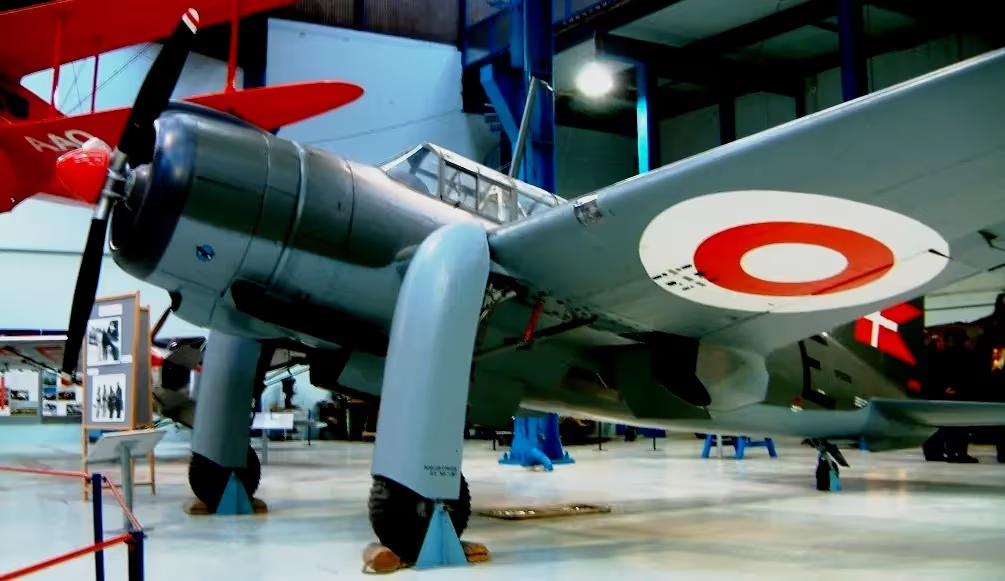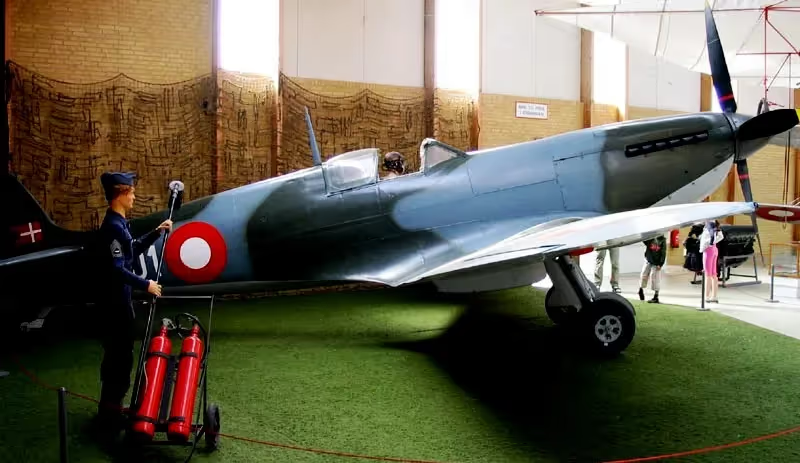Denmark: Warplanes of the Second World War preserved
Warplanes of the Second World War preserved in Denmark
The aim of this website is to locate, identify and document Warplanes from the Second World War preserved in Denmark. Many contributors have assisted in the hunt for these aircraft to provide and update the data on this website. Photos are as credited. Any errors found here are by the author, and any additions, corrections or amendments to this list of Warplane Survivors of the Second World War in Denmark would be most welcome and may be e-mailed to the author at [email protected].
Krigsfly fra 2. verdenskrig bevaret i Danmark
Denmark
On 31 May 1939, Denmark and Germany signed a treaty of non-aggression, which did not contain any military obligations for either party. On 9 April 1940, citing the intended laying of mines in Norwegian and Danish waters as a pretext, Germany invaded both countries. The Danes had a very small air force attached to the Army. They had no military effect on the German invasion of Denmark; most aircraft were destroyed or captured on the ground. They were organized into two Aviation Battalions. The Jutland Battalion had one fighter squadron equipped with 13 Fokker D.XXI one reconnaissance squadron equipped with 11 biplanes, and the Saeland Battalion was equipped with 8 Fokker G.Ia and one reconnaissance squadron equipped with 14 biplanes.
King Christian X and the Danish government, worried about German bombings if they resisted occupation, accepted “protection by the Reich” in exchange for nominal independence under German military occupation. Three successive Prime Ministers, Thorvald Stauning, Vilhelm Buhl, and Erik Scavenius, maintained this samarbejdspolitik (“cooperation policy”) of collaborating with Germany.
Denmark coordinated its foreign policy with Germany, extending diplomatic recognition to Axis collaborator and puppet regimes, and breaking diplomatic relations with the governments-in-exile formed by countries occupied by Germany. Denmark broke diplomatic relations with the Soviet Union and signed the Anti-Comintern Pact of 1941.
In 1941 a Danish military corps, the Frikorps Danmark, was created at the initiative of the SS and the Danish Nazi Party, to fight alongside the Wehrmacht on Germany’s Eastern Front. Frikorps Danmark was open to members of the Danish Royal Army and those who had completed their service within the last ten years. Between 4,000 and 10,000 Danish citizens joined the Frikorps Danmark, including 77 officers of the Royal Danish Army. An estimated 3,900 of these soldiers died fighting for Germany during the Second World War.
Denmark transferred six torpedo boats to Germany in 1941, although the bulk of its navy remained under Danish command until the declaration of martial law in 1943.
The Danish protectorate government lasted until 29 August 1943, when the cabinet resigned following a declaration of martial law by occupying German military officials. Germany declared war on Denmark and attacked the Danish military bases which led to 13 Danish soldiers dead in the fighting. The Danish navy scuttled 32 of its larger ships to prevent their use by Germany. Germany seized 14 larger and 50 smaller vessels, and later raised and refitted 15 of the sunken vessels. During the scuttling of the Danish fleet, a number of vessels attempted an escape to Swedish waters, and 13 vessels succeeded, four of which were larger ships. By the autumn of 1944, these ships officially formed a Danish naval flotilla in exile. In 1943 Swedish authorities allowed 500 Danish soldiers in Sweden to train as police troops. By the autumn of 1944, Sweden raised this number to 4,800 and recognized the entire unit as a Danish military brigade in exile. Danish collaboration continued on an administrative level, with the Danish bureaucracy functioning under German command. (Wikipedia)
Aviation Museums in Denmark
Forsvars – og Garnisonsmuseum, Aalborg Defence and Garrison Museum, Skydebanevej 22, Aalborg 9000.
Marinemuseum, Vestre Fjordvej 81, Aalborg 9000.
Danmarks Tekniske Museum, Fabriksvej 25, DK-3000 Helsingor.
Hjallerup Mekaniske Museum, Algade 42, 9320 Hjallerup.
Flyvestation Karup’s Historiske Forening Museet, Karup Air Base Museum.
Egeskov Veteran Car Museum, Egeskov Castle, Egeskov Gade 18, 5772 Kvaerndrup.
Danish Collection of Vintage Flying Aircraft, Stauning Airport, Dansk Veteranflysambling, Lufthavnsvej Stauning, Skjern 6900.
Warplanes of the Second World War preserved in Denmark by aircraft type, serial number, registration number and location:

(Peter Bakema Photo)
Douglas C-47A Skytrain (Serial No. K-682), Danish Dakota Friends, Reg. No. OY-BPB, STA Stauning, Denmark.

(Mike Freer - Touchdown-aviation Photo)
Consolidated PBY-6A Catalina (BuNo. 63993), Royal Danish Air Force (Serial No. L866).

(Paul Richter Photo)

(Per80 Photo)
Saab 17A Swedish bomber-reconnaissance aircraft with Danish insignia, on display at the Danish Technical Museum, Helsingor, Denmark.
For some months from very early 1945, 15 B 17A were issued to DANFORCE (Danish Brigade of 5000 men in Sweden). However, as things unfolded with the German surrender, there was no use for these in the liberation of Denmark, and the aircraft were returned to the Flygvapnet a couple of months after the German surrender.

(Slaunger Photo)

(Aldipower Photo)
SAI KZ IV, Reg. No. OY-DIZ, light twin-engined aircraft first built in Denmark in 1944 for use as an air ambulance. Danish Collection of Vintage Aircraft, Stauning.
It was a conventional, low-wing cantilever monoplane with twin tails, mounted on the ends of the horizontal stabiliser. Power was provided by two engines mounted in nacelles on the wings that also housed the main units of the fixed, tailwheel undercarriage. The cabin could hold two stretchers, two medical attendants, and a flight crew of two.
One KZ IV, Reg. No. OY-DIZ, was built during the war, with a second aircraft, Reg. No. OY-DZU being built and flown in 1949. That same year, the OY-DIZ was christened with the name "Folke Bernadotte" in honour of the Swedish count who had used this very aircraft to make a diplomatic visit to Germany to negotiate for the release of Danish prisoners in German concentration camps near the end of the war. This aircraft is now the "flagship" of the Danmark's Flymuseum collection, having been restored to its original wartime configuration and markings following a career as a utility aircraft in England and a crash in 1979. The second aircraft was actively operational until the mid 1960s.

(Stahlkocher Photo)

(Euro-t-guide.com Photo)

(Sam Wise Photo)
Supermarine Spitfire HF Mk. IXe (Serial No. MA298), RFAF (Serial No. 41-401). After the German occupation, the Royal Danish Air Force acquired 38 HF Mk. IXe and 3 PR Mk. XI Spitfires. The Spitfires were phased out and replaced by jets between 1951 and 1955. All but two were scrapped. For a number of years, one was placed in a children's playground. The last survivor is exhibited at Danmarks Flymuseum, Stauning, Denmark.

(Rept0n1x Photo)
Danish Presentation Spitfire, "Valdemar Atterdag" at the 2014 Birkenhead Park Festival of Transport, Merseyside, England.
During the Second World War many Danes who escaped from German occupation of their country joined the Royal Air Force or the hereto attached Norwegian units. Among them were several Danish fighter pilots.
Considerably less known is the story of aircraft donation by Free Danes around the World in support of their fighting airmen. In 1941-1942, worldwide collection of funds among the Danish community in exile resulted in bringing up a sum of over £40,113 for a number of Spitfires to be flown by Danish pilots in the Royal Air Force squadrons.
In 1940, while the air war was raging in the skies over Southern England, a large number of Spitfire Funds were set up all over the world by corporations, counties, organisations and the like, with the aim of raising money for aircraft production. The tradition of donating money for weapons for the armed forces was not new; for centuries armament had been supplied by private initiative. In dark times, as the German forces were planning to cross the Channel, the idea caught on again.
In the summer of 1941, a delegation of the Danish Freedom Council in London travelled North and South America to visit free Danish on this continent. Inspired by an initiative among Danes in Eastern U.S. it was decided to start a worldwide collection of funds; a Fighter fund was set up.
On 9 April 1942, two years after the German occupation of Denmark, the result of the collection was presented to Prime Minister Winston Churchill in his office on 10 Downing Street. The delegation consisted of representatives of the Danish Council in London, the leader of the Danish recruitment office in London, Captain Iverson, P/O Jørgen Thalbitzer, machinist P. H. Skov, and seaman Helge Christensen. The £ 38,000 that were donated on this day were eventually increased to a total of £ 40,113. The aim was to donate 8 Spitfires for the Royal Air Force.
On the following day the first three aircraft were presented to the representatives of No. 234 (Madras Presidency) Squadron during an official ceremony at RAF Coltishall. In service with this unit were three Danish fighter pilots, P/O Jørgen Thalbitzer, P/O Aksel A. Svendsen and P/O Jens Ipsen, who also demonstrated the aircraft in the air. Present were also C.E. Aagaard, Danish ambassador to Sweden, Krøyer-Kielgaard, president of the Danish Council, Anker-Petersen, J. Wullf, H.T. Karsten, and E. Hertel.
The three Spitfires were given the names "Skagen Ind", "Niels Ebbesen", and "Valdemar Atterdag".

(Royal Danish Library Photo)
Supermarine Spitfire Mk. Vb, RAF (Serial No. BL924), "Skagen Ind", 10 April 1942.
Skagen Ind means "Inbound the Skaw" (the Skaw or Skagen in Danish is the northernmost tip of Denmark). It relates to a phrase used by Danish seamen approaching Denmark from the North Sea.
Niels Ebbesen was a Danish 14th century national hero. In 1340, he killed the German count Gerhard 3 of Holstein. The murder eventually lead to the end of the counts of Holstein ruling Denmark and King Valdemar 4 Atterdag seizing power.
Valdemar Atterdag. King Valdemar 4 Atterdag was a medieval Danish king who reigned from 1340 to 1375.
The Free Danes’ Spitfire Fund originally planned a donation of 8 Spitfires in all. According to Boot and Sturtivant (2005) four Spitfires and a Handley Page Hampden were donated.
The fourth Spiftire (mark and serial number unknown) was given the name "Holger Danske", after another Danish national figure. According to the legend, Holger Danske is asleep beneath Kronborg Castle in Elsinore, but he will awake and come to the rescue if Denmark is in real danger.
Finally a Handley Page Hampden, (Serial No. AT524) (or possibly AT254) was given the name "King Kristian d. X". If indeed it was AT254, the aircraft was allocated to 489 (RNZAF) Squadron. Danish pilot Henning Petersen flew the aircraft.
(Mikkel Plannthin, using the following sources: Boot and Sturtivant, Gifts of War – ‘Presentation Aircraft’ in Two World Wars 2005; Palmér, 1945; Ancker, 2001; Air Ministry, Form 78, BL830,BL831, BL830; AIR 27/1439 AIR 27/1439)

(US Library of Congress Photo)
Danish Pilot Officer Jørgen Billy Thalbitzer (1920-1943) who served with the RAF in England, with the presentation Spitfire "Niels Ebbesen", 10 April 1942.
Luftwaffe aircraft in Denmark at the end of the Second World War

(IWM Photo, CL 3303)
Junkers Ju 88 night fighters awaiting scrapping at Grove airfield in Denmark, 2 August 1945.





